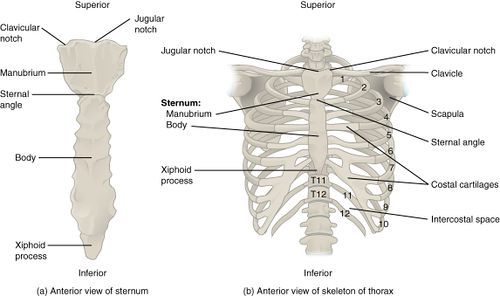Biomechanics of the Thorax
Original Editor - User Name
Top Contributors - Sonal Joshi and Manisha Shrestha
This article is currently under review and may not be up to date. Please come back soon to see the finished work! (15/12/2021)
Introduction[edit | edit source]
Biomechanics is an area of science that uses principles of physics to measure and study, how forces interact with and affect living body[1]. These forces could be Internal i.e. within the body or External i.e. outside the body.
To understand the biomechanics of thorax we will need to study the basic anatomy, joint articulations, muscles associated in the thorax along with kinematics of the rib cage.
The thorax is formed by the thoracic vertebrae ,the ribs and the sternum.
It has two main functions,
- Providing anchor for muscle attachments
- Major role of ventilation
Structure of Thorax[edit | edit source]
This is the cornerstone of understanding how the thorax works.
Rib Cage[edit | edit source]
Anatomy[edit | edit source]
The rib cage is a system of various bones and muscle. Bones involved are sternum, 12 pairs of Ribs, 12 Thoracic vertebrae.
The borders of ribcage consist of:
- Anterior border: sternum
- Lateral border: Ribs
- Posterior border: Thoracic vertebrae
- Superior border: Jugular notch of sternum, superior borders of costocartilages, first rib and its connecting vertebrae
- Inferior border: xiphoid process, costocartilages of 6 to 10th ribs, inferior portion of 11th & 12th ribs and 12th thoracic vertebrae
Refer the Thoracic Anatomy for further details of Thoracic vertebrae & the joint which they form.
Articulations[edit | edit source]
| Joint | Bones involved in the joint articulation | Special features | |
|---|---|---|---|
| Manubriosternal | Manubrium and superior part of body of Sternum | - Synchondrosis type of joint
- Also called Angle of Louis |
|
| Xiphisternal | Xiphoid process and inferior part of body of Sternum | - Synchondrosis type of joint
- Ossifies by 40 to 50 yrs. of age |
|
| Typical Costovertebral | - Synovial type of joint | ||
| Costotransverse | |||
| Costochondral | |||
| Costosternal | |||
| Interchondral |
Function of Thorax[edit | edit source]
Kinematics[edit | edit source]
Muscles involved in Rib Cage[edit | edit source]
Primary Muscles[edit | edit source]
- Diaphragm
- Intercoastal muscles
- Scalene
Accessory Muscles[edit | edit source]
- Sternocleidomastoid
- Trapezius
- Pectoralis major
- Pectoralis minor
- Subclavius
- Levatores costarum
- Serratus posterior superior
- Serratus posterior inferior
- Abdominal muscles
- Transverse thoracis
Developmental Differences with Age[edit | edit source]
Pathological Changes[edit | edit source]
References[edit | edit source]
- ↑ Neumann DA. Kinesiology of the musculoskeletal system-e-book: foundations for rehabilitation. Elsevier Health Sciences; 2016 Nov 3.







